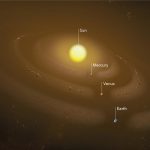Planet-forming disks around stars may come preloaded with ingredients for life0
- From Around the Web, Space
- May 12, 2021
Methanol found around a hot, young star must have formed in cooler interstellar environs

Methanol found around a hot, young star must have formed in cooler interstellar environs

That glow you see at sunrise or sunset is caused by cosmic dust. For decades astronomers thought it came from asteroids but now they’re not so sure

Radioactive dust deep beneath the ocean waves suggests that Earth is moving through a massive cloud left behind by an exploded star.

Every year, our planet encounters dust from comets and asteroids. These interplanetary dust particles pass through our atmosphere and give rise to shooting stars. Some of them reach the ground in the form of micrometeorites. An international program conducted for nearly 20 years by scientists from the CNRS, the Université Paris-Saclay and the National museum of natural history with the support of the French polar institute, has determined that 5,200 tons per year of these micrometeorites reach the ground. The study will be available in the journal Earth & Planetary Science Letters from April 15.

A new approach to space housekeeping sends charged dust particles flying

Scientists study the chemical composition of meteorites.

Planets that had been written off as uninhabitable could in fact be more likely to serve as home for life than previously thought, research indicates

Isotope found in seabed sediment points to clash of solar bodies near Mars, study suggests

Just as dust gathers in corners and along bookshelves in our homes, dust piles up in space too. But when the dust settles in the solar system, it’s often in rings. Several dust rings circle the Sun. The rings trace the orbits of planets, whose gravity tugs dust into place around the Sun, as it drifts by on its way to the center of the solar system.

It may not take an asteroid strike to transport life from one planet to another.